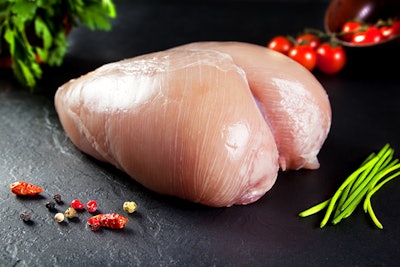
The use of electrostatic technology to apply paracetic acid (PAA) on whole muscle cuts was effective as an antimicrobial intervention, according to research presented during the International Production & Processing Expo (IPPE) Marketplace.
Electrostatic technology is a novel approach to applying cleaners, sanitizers and disinfectants to protect poultry products and improve food safety. The technique charges liquids as they pass through a sprayer nozzle. The droplets repel each other and instead seek out surfaces, resulting in a uniform coating and avoiding the liquid pooling often associated with trigger sprays.
“The best way I can describe electrostatic attraction is if you have two magnets of opposite polar and as you move those magnets closer together, they suddenly snap together and are difficult to pull apart,” Bob Ogren, VP, Equipment Division at Birko Corporation, explained during the Tech Talk, “Antimicrobial Efficacy Test in Pineland Farms Plant Using Electrostatic Technology.”
“We’re doing in essence the same thing while charging the antimicrobial solution. We negatively charge the solution at the source and then apply it to said product going through a conveyance system.”
Electrostatic attraction results in as high transfer efficiency, typically between 90 to 95%. This means that less than 10% of the applied solution ends up somewhere other than the intended environment.
Testing the effectiveness
In initial tests, electrostatic technology displayed a transfer efficiency approaching 90-100%. Additionally, a follow up antimicrobial validation study showed up to a 2.0 log reduction on the product coming out, with nearly a 360’ product covering.
The technology was further tested at Pineland Farms in a pilot study.
For the study, 40 subprimal pieces were treated with PAA at a concentration of 1,450 ppm using electrostatic technology. The solution was applied for approximately 20 seconds. Half of the pieces were swabbed prior to the electrostatic treatment, while the others were swabbed post-treatment.
Laboratory tests showed that PAA was highly effective at reducing the microbial load when applied using electrostatic technology and the 3.63 log pretreatment was reduced by up to 2.48 log post-treatment.
Read more from IPPE Marketplace.
Like what you just read? Sign up now for free to receive the Poultry Future Newsletter.

















